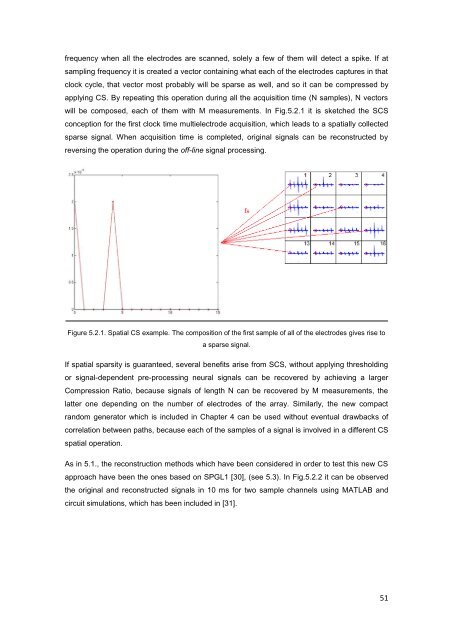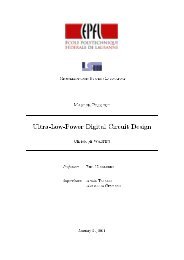Compressive Sensing system for recording of ECoG signals in-vivo
Compressive Sensing system for recording of ECoG signals in-vivo
Compressive Sensing system for recording of ECoG signals in-vivo
You also want an ePaper? Increase the reach of your titles
YUMPU automatically turns print PDFs into web optimized ePapers that Google loves.
frequency when all the electrodes are scanned, solely a few <strong>of</strong> them will detect a spike. If atsampl<strong>in</strong>g frequency it is created a vector conta<strong>in</strong><strong>in</strong>g what each <strong>of</strong> the electrodes captures <strong>in</strong> thatclock cycle, that vector most probably will be sparse as well, and so it can be compressed byapply<strong>in</strong>g CS. By repeat<strong>in</strong>g this operation dur<strong>in</strong>g all the acquisition time (N samples), N vectorswill be composed, each <strong>of</strong> them with M measurements. In Fig.5.2.1 it is sketched the SCSconception <strong>for</strong> the first clock time multielectrode acquisition, which leads to a spatially collectedsparse signal. When acquisition time is completed, orig<strong>in</strong>al <strong>signals</strong> can be reconstructed byrevers<strong>in</strong>g the operation dur<strong>in</strong>g the <strong>of</strong>f-l<strong>in</strong>e signal process<strong>in</strong>g.Figure 5.2.1. Spatial CS example. The composition <strong>of</strong> the first sample <strong>of</strong> all <strong>of</strong> the electrodes gives rise toa sparse signal.If spatial sparsity is guaranteed, several benefits arise from SCS, without apply<strong>in</strong>g threshold<strong>in</strong>gor signal-dependent pre-process<strong>in</strong>g neural <strong>signals</strong> can be recovered by achiev<strong>in</strong>g a largerCompression Ratio, because <strong>signals</strong> <strong>of</strong> length N can be recovered by M measurements, thelatter one depend<strong>in</strong>g on the number <strong>of</strong> electrodes <strong>of</strong> the array. Similarly, the new compactrandom generator which is <strong>in</strong>cluded <strong>in</strong> Chapter 4 can be used without eventual drawbacks <strong>of</strong>correlation between paths, because each <strong>of</strong> the samples <strong>of</strong> a signal is <strong>in</strong>volved <strong>in</strong> a different CSspatial operation.As <strong>in</strong> 5.1., the reconstruction methods which have been considered <strong>in</strong> order to test this new CSapproach have been the ones based on SPGL1 [30], (see 5.3). In Fig.5.2.2 it can be observedthe orig<strong>in</strong>al and reconstructed <strong>signals</strong> <strong>in</strong> 10 ms <strong>for</strong> two sample channels us<strong>in</strong>g MATLAB andcircuit simulations, which has been <strong>in</strong>cluded <strong>in</strong> [31].51















